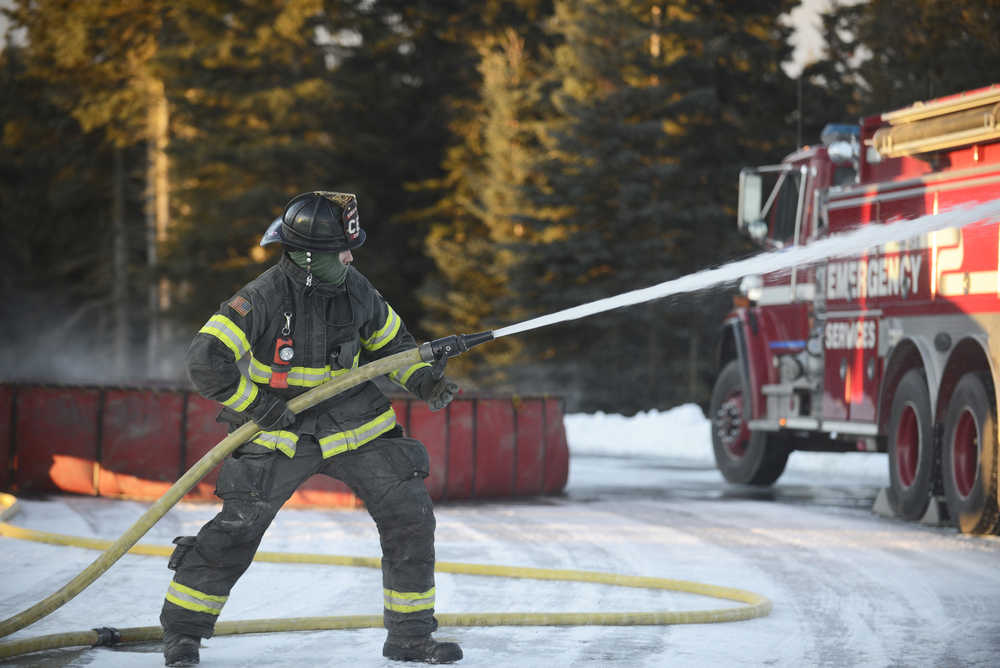Frosty air that dipped below zero degrees Fahrenheit on Tuesday froze a Central Emergency Services hydrant shut, but it couldn’t keep firefighters from their last rounds of practice before an engineering exam this week.
A handful of CES personnel have been training for about two months in preparation for a test that, if passed, will allow them to progress to the next step in firefighting. The department tries to keep about six engineers on each shift, said Engineer Jay Morrison, an engineer with CES since 2008 who has overseen the training. With three members of CES preparing to retire, Morrison said it is pertinent for the organization to get more of its firefighters certified to serve as engineers as well.
“We’ve been needing engineers for quite a while,” he said. “Just through attrition we’ve been losing people, so we’re trying to move up some people to fill some positions.”
Engineers do all the fire, emergency and medical response that firefighters do, but they are also qualified to drive and operate all the CES vehicles and tools, including the 75-foot ladder truck. CES tries to provide the engineer training every two to three years or as needed, Morrison said. After that, keeping up on the skills needed to be an engineer are basically built into the everyday regimen of working at CES, he said.
The firefighters began their training in September with three straight weeks of class work and physical training, after which Morrison said they were put back on their regular shifts for a month to do more hands-on practice. They took up practice again for two days starting Tuesday as a last refresher before the exam on Thursday.
Nate Nelson has been with CES for just under two years after joining the Nikiski Fire Department in 2007. He said being able to take training from more than once place and put it together has been a positive experience.
“I’ve learned a lot of good things in this class,” Nelson said. “And it’s been good to see different viewpoints from different departments.”
While becoming qualified as an engineer is a natural progression in the firefighting field, Morrison said more and more of the newer CES members are getting exposure to the training earlier in school. This has made his most recent class challenging in terms of providing them with new ground to cover, he said.
“It’s just been a high-level class, because you’re teaching people that already have some knowledge about it anyway,” Morrison said. “It definitely keeps you on your toes as an instructor to challenge them.”
Firefighters went through what Morrison called a changeover drill on Tuesday, which he said helps them practice switching from one water source to another quickly. They took turns pumping water from a tank into one of the CES engines, with a tanker, which has more carrying capacity, standing nearby. The frozen fire hydrant complicated their plants, so Morrison had the men switch to vehicle maintenance.
In addition to a written test, the firefighters will be tested on how well they can operate the ladder truck, will be required to do top-to-bottom maintenance on all the trucks, and are required to have racked up a number of driving hours and miles.
One of the biggest challenges when it comes to engineer training is getting firefighters comfortable being in the drivers seat of CES trucks and engines, Morrison said.
“These trucks are not your average pickup trucks. They’re 80,000 pounds going down the road and in the winter time they’re hard to stop, so we put a lot of time into the driving portion of the class also,” Morrison said. “Now you’re responsible for everybody in the cab, so we have to kind of get everybody comfortable so the nerves don’t come out at 3 o’clock in the morning.”
Nelson echoed Morrison’s sentiments, saying that being responsible for not only the vehicles, but the people who rely on water from them, is the biggest difference between the two jobs.
“When you are an engineer you are in charge of an apparatus, making sure that it is in service and ready to respond at all times, and you’re also responsible for the firemen that are on your apparatus,” Nelson said. “So on any given scene, you will be operating an apparatus that the firefighters inside rely on with their lives, and so the potential is there and the responsibility is great.”
Reach Megan Pacer at megan.pacer@peninsula.com.

